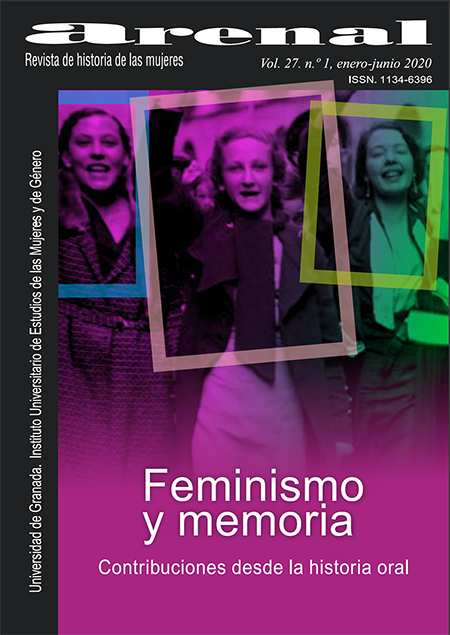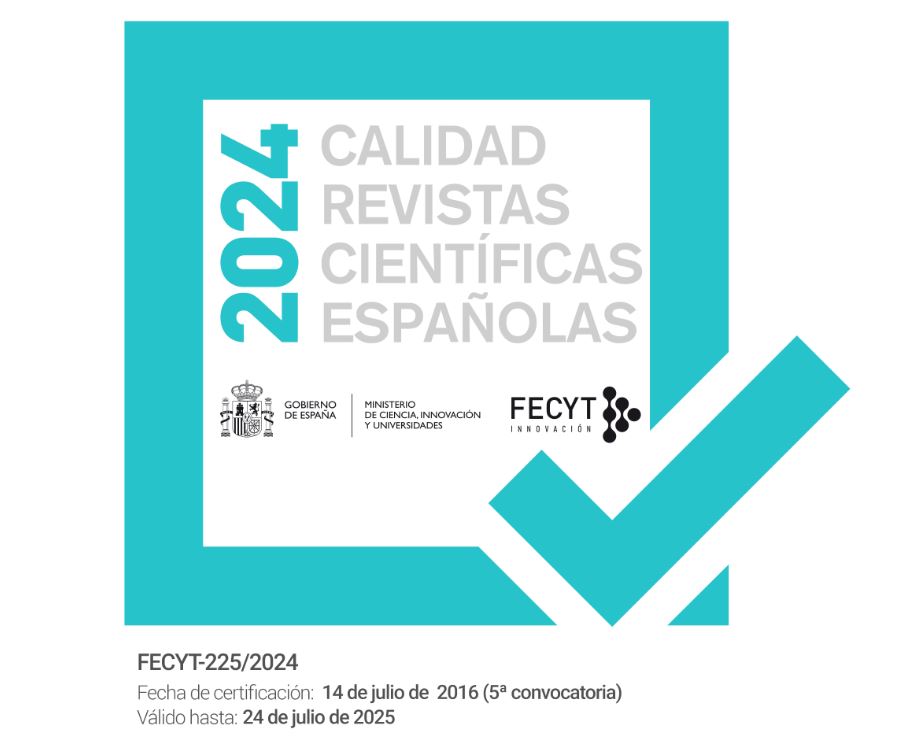Mothers for Sale: The case of the Wet Nurse in the Greek and Roman World
DOI:
https://doi.org/10.30827/arenal.v27i1.6354Keywords:
Wet nurse, Sexual diseases, Breastfeeding, Motherhood, Ancient Greece and RomeAbstract
Both literary and material evidence suggest that wet nurses (women who took care of babies without being their mothers) played a central role within ancient families. While they were often beloved members of those families, they were also ambiguous and elusive social figures. This could be surprising if we consider that wet nurses saved many lives and hugely helped mothers. I will try to investigate the figure of the wet nurse through a comparison with the prostitute, and by focusing on her maternity. It seems clear that the conditions and life-style of wet nurses were not significantly different in ancient Greece and Republican Rome, and I almost exclusively base my speculation on Roman Imperial evidence. By using the concept of longue durée, I will also try to make comparisons with other historical periods, in order to strengthen my reconstruction.
Downloads
References
ABOU ALY, Amal (1986): “The wet nurse: A study in ancient medicine and Greek papyri”. The Vesalius, 2-2: 86-97.
BIRCHLER EMERY, Patricia (2008): “Vieillards et vieilles femmes en Grèce archaïque : de la calvitie et des rides”. In DASEN, Véronique and WILGAUX, Jérôme (eds.): Langages et métaphores du corps dans le monde antique. Rennes, Presses universitaires de Renne, pp. 61-72. DOI: https://doi.org/10.4000/books.pur.5420
BOLLAERT, William (1864): “Introduction of Syphilis from the New World”. Journal of the An- thropological Society of London, 2: cclvi-cclxix. DOI: https://doi.org/10.2307/3025228
BRADLEY, Keith R. (1986): “Wet-nursing at Rome: A Study in Classical Relations”. En RAWSON, Beryl (ed.): The Family in Ancient Rome: New Perspectives. London-Sydney, Croom Helm, pp. 201-229.
COLES, Prophecy (2015): The shadow of the second mother. Nurses and nannies in theories of infant development. New York, Routledge. DOI: https://doi.org/10.4324/9781315739892
D’AMELIA, Marina (ed.) (1997): Storia della maternità. Roma-Bari, Laterza.
DASEN, Véronique (2010): “Des nourrices grecques à Rome?” In PACHE-HUBER, Vèronique and DASEN, Vèronique (eds.): Politics of Child Care in Historical Perspective. Special issue of Paedagogica Historica 46, pp. 699-713. DOI: https://doi.org/10.1080/00309230.2010.526330
DIXON, Suzanne (1988): The Roman Mother. Norman-London, University of Oklahoma Press. DJÉRIBI, Muriel (1998): “Le Mauvais œil et le lait”. L’homme, 105: 35-47. DOI: https://doi.org/10.3406/hom.1988.368933
FILDES, Valerie (1986): Breasts, Bottles and Babies. A History of Infant Feeding. Edinburgh, Edinburgh University Press.
GARNSEY, Peter (1991): “Child Rearing in Ancient Italy”. In KERTZER, David i. and SALLER, Richard P. (eds.): The Family in Italy from Antiquity to the Present. London, Yale University Press, pp. 48-65.
Gregorio Navarro, Maria Carmen D. (2015): “Violencia de género y privación de libertad en el mundo clásico”. In DOMÍNGUEZ ARRANZ, Almudena and MARINA SÁEZ, Rosa M. (eds.): Género y enseñanza de la Historia. Silencios y ausencias en la construcción del pasado. Ma- drid, Silex, pp. 269-290.
HARPER, Kyle (2013): From Shame to Sin. The Christian Transformation of Sexual Morality in Late Antiquity. Cambridge-London, Harvard University Press, 2013. DOI: https://doi.org/10.4159/harvard.9780674074569
HENNEBERG, Maciej and HENNEBERG, Renaia J. (1994): “Treponematosis in an Ancient Greek colony of Metaponto, Southern Italy 580-250 BCE”. In DUTOUR, Olivier et al. (eds.): The Origin of Syphilis in Europe, Before or After 1493? Toulon-Paris. Centre Archeologique du Var, Editions Errance, pp. 92-98.
HENNEBERG, Maciej and HENNEBERG, Renaia J. (2002): “Reconstructing Medical Knowledge in Ancient Pompeii from the Hard Evidence of Bones and Teeth”. In CASTAGNETTI, Giuseppe (ed.): Homo Faber: Studies on Nature. Technology and Science at the Time of Pompeii. Rome, L’Erma di Bretschneider, pp. 169-187.
JONES, Louis C. (1951): “The Evil Eye among European-Americans”. Western Folklore, 10-1: 11-25. KELLER, Heidi, et al. (2009): “Distal and proximal parenting as alternative parenting strategies during infants’ early months of life: A cross-cultural study”. The International Journal of Behavioral Development, 33-5: 412-420. DOI: https://doi.org/10.1177/0165025409338441
KERTZER, David I. (2008): Amalia’s Tale. Boston, Houghton Mifflin Harcourt. KOSMOPOULOU, Angeliki (2001): “Working Women: Female Professionals on Classical Attic Gravestones”. The Annual of the British School at Athens, 96: 281-319. DOI: https://doi.org/10.1017/S006824540000530X
LAES, Christian (2010): “The Educated Midwife in the Roman Empire”. In HORSTMANSHOFF, Mafred (ed.): Hippocrates and Medical Education. Leiden-Boston, Brill, pp. 261-286. DOI: https://doi.org/10.1163/ej.9789004172487.i-566.75
LOBDELL, John, y OWSLEY, Douglas (1974). “The origin of syphilis”. Journal of Sex Research, 10- 1: 76-79. DOI: https://doi.org/10.1080/00224497409550828
MEDINA QUINTANA, Silvia (2010). “Las nodrizas: una maternidad comprada”. In CID LÓPEZ, Rosa Maria (ed.): Maternidad/es: representaciones y realidad social. Edades antigua y media. Madrid, Almudayna, pp. 203-214.
MENCACCI, Francesca (1995): “La balia cattiva: alcune osservazioni sul ruolo della nutrice nel mondo antico”. In RAFFAELLI, Renato and DANESE, Roberto M. (eds.): Vicende e figure femminili in Grecia e a Roma. Ancona, Commissione per le pari opportunità tra uomo e donna della Regione Marche, pp. 227-237.
MENCACCI, Francesca (forthcoming): “Parentela e quasi-parentela. Pedagoghi, nutrici e altri ruoli “vicari” nella letteratura latina”. En PICONE, Giusto (ed.): Ghenos/genus. Parentela, società, letteratura in Gecia e a Roma, Bari.
MIRÓN PÉREZ, María Dolores (2005): “Nodrizas griegas: alimentando el cuerpo y el alma”. In FLECHA GARCÍA Carmela, NÚÑEZ GIL, Marina AND REBOLLO ESPINOSA, Ma José (eds.): Mujeres y educación. Saberes, prácticas y discursos en la Historia. Sevilla, Buenos Aires, Diputación Provincial de Sevilla, Miño y Dávila, pp. 43-54.
MOLINOS TEJADA, Maria Teresa (2001): “Las nodrizas en la escena clásica”. In DE MARTINO, Francesco and MORENILLA TALENS, Carmen (eds.): El Fil d’Ariadna. Universitat de València 3-5 de maig 2000. Bari, Levante, pp. 299-316.
PEDRUCCI, Giulia (2013): L’allattamento nella Grecia di epoca arcaica e classica. Roma, Scienze e Lettere.
PEDRUCCI, Giulia (2014): “Cuccioli d’uomo, cuccioli di cane. Nuove proposte per l’interpretazione del materiale proveniente dalla necropoli di Lugnano Teverina”. In TERRANOVA, Chiara (ed.): La presenza degli infanti nelle religioni del Mediterraneo antico. Roma, Aracne, pp. 185-216.
PEDRUCCI, Giulia (2015): “Baliatico, aidos e malocchio: capire l’allattamento nella Grecia di epoca arcaica e classica anche con l’aiuto delle fonti romane”. EuGeStA 5: 27-53. DOI: https://doi.org/10.54563/eugesta.1195
PEDRUCCI, Giulia (2016a): “Breastfeeding Animals and other wild ‘Nurses’ in Greek and Roman Mythology”. Gerión 34: 307-323. DOI: https://doi.org/10.5209/rev_GERI.2016.v34.53745
PEDRUCCI, Giulia (2016b): “Allaitements transgressifs dans l’antiquité gréco-romaine». Dialogues d’Histoire Ancienne, 45: 131-145. DOI: https://doi.org/10.3917/dha.hs19.0131
PEDRUCCI, Giulia (2018): Maternità e allattamenti nel mondo greco e romano. Un percorso fra storia delle religioni e studi sulla maternità. Roma, Scienze e Lettere, 2018.
PEDRUCCI, Giulia and SCAPINI, Marianna (2017): “Il ruolo della balia e di altre figure vicarie legate all’infanzia nella religione greca e romana: Arreforie e Matralia a confronto”. In PASCHE GUIGNARD, Florence I. et al. (eds.): Maternità e politeismi – Motherhood(s) and Polytheisms. Bologna, Patron, pp. 326-358.
PERRY, Matthew J. (2014): Gender, Manumission, and the Roman Freedwoman. New York, Cam- bridge University Press. DOI: https://doi.org/10.1017/CBO9781139628853
RÄUCHLE, Victoria (2015): “For youth is impressionable and plastic”. AHA, Meeting January, 2-5. ROUSSELLE, Aline (1988): Porneia. On Desire and the Body in Antiquity. Cambridge MA, Blackwell (or. ed. Porneia, Paris 1983).
SHAW, Teresa M. (1998): The Burden of the Flesh. Fasting and Sexuality in Early Christianity. Minneapolis, Fortress Press.
TAWFIK, Zeinab (1997): “Wet-Nursing Stipulations in Greek Papyri and Arabic Sources”. In KRA- MER, Barbel (ed.): Akten des 21. internationalen Papyrologenkongresses. Stuttgart-Leipzig, B.G. Teubner, pp. 939-953.
Downloads
Published
How to Cite
Issue
Section
License
Los/as autores/as que publican en esta revista están de acuerdo con los siguientes términos:
Los autores/as conservarán sus derechos de autor y garantizarán a la revista el derecho de primera publicación de su obra, el cuál estará simultáneamente sujeto a la Licencia de reconocimiento de Creative Commons 4.0 BY-NC-ND que permite a terceros compartir la obra siempre que se indique su autor y su primera publicación esta revista.
Los autores/as podrán adoptar otros acuerdos de licencia no exclusiva de distribución de la versión de la obra publicada (p. ej.: depositarla en un archivo telemático institucional o publicarla en un volumen monográfico) siempre que se indique la publicación inicial en esta revista.
Se permite y recomienda a los autores/as difundir su obra a través de Internet (p. ej.: en archivos telemáticos institucionales o en su página web) antes y durante el proceso de envío, lo cual puede producir intercambios interesantes y aumentar las citas de la obra publicada. (Véase El efecto del acceso abierto).














